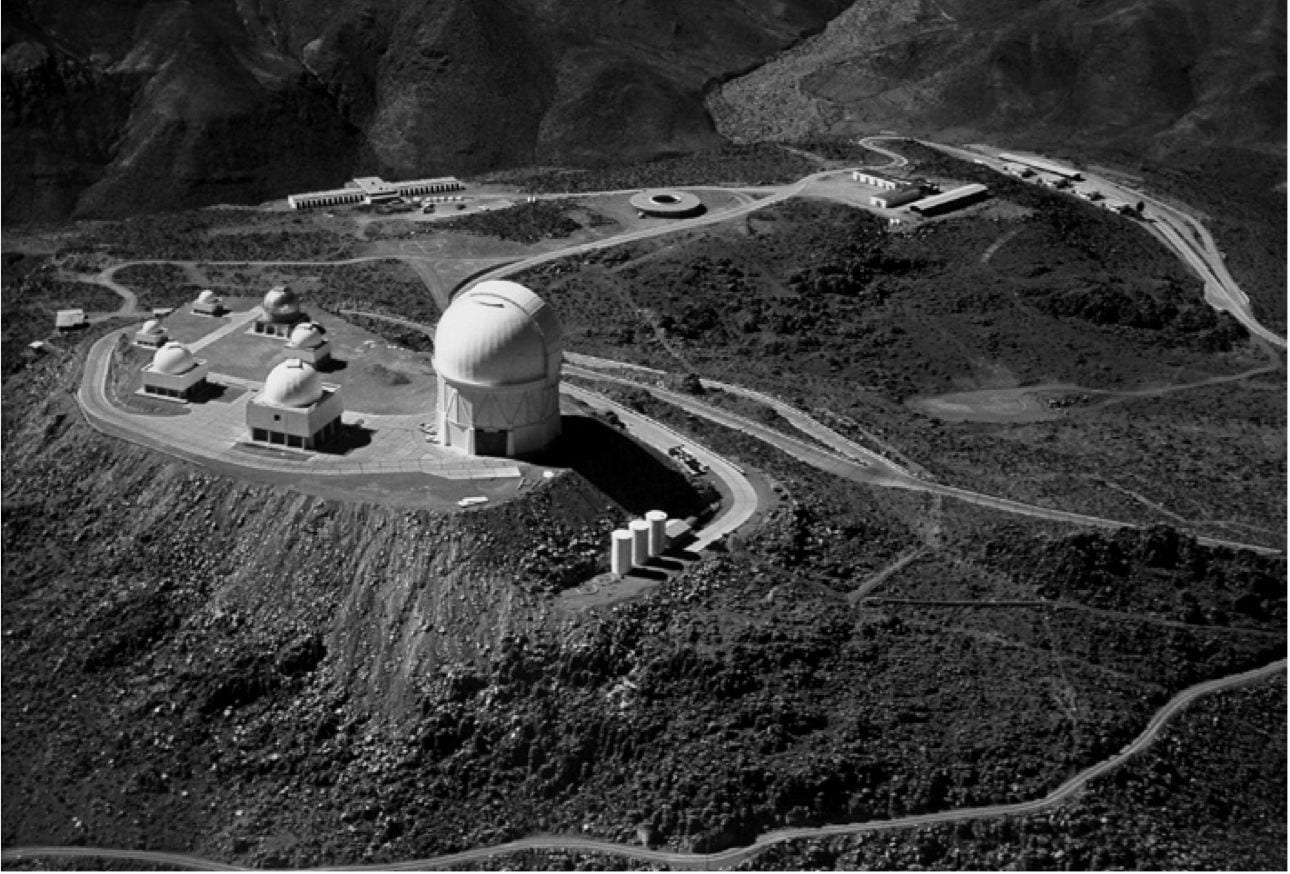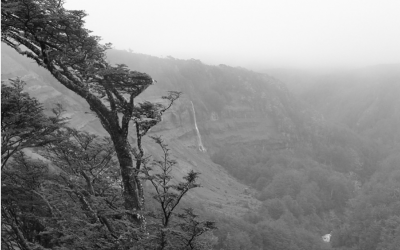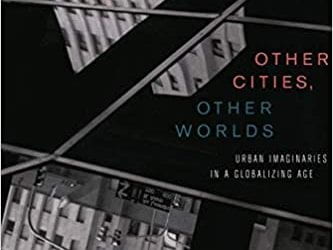An Astronomical Scene
Learning at the PUC

Aerial view of cerro tololo inter-american observatory in chile, taken in the late 1970s. Photo by D. Isbell and NOAO/AURA/NSF
Where can you find an Italian professor teaching an American student in Spanish using lecture slides written in English?
In the astronomy course I took at Chile’s Pontifícia Universidad Católica (PUC), few sentences were spoken in only one language. As an undergraduate student of astronomy at Harvard College taking a semester abroad, I felt strangely close to home—finally here was a course taught in Spanglish. Yet this odd mix of the domestic and the foreign was rather appropriate for the subject matter. The advanced state of astronomical research in Chile has always owed much to international involvement.
Northern Chile’s dry, predictable weather has been a draw for astronomers for more than a century. The Atacama was the place to go to make the most acute and critical observations. In 1907, famed astronomer Percival Lowell obtained his photographic “proof” of canals on Mars when he worked in a little town just south of Antofagasta. Complete with mule-drawn wagons and porters, such undertakings were not unlike the African expeditions of Victorian days. Significantly, they were sponsored by foreign universities and came to Chile with their own staff and equipment. This pattern of detachment from Chilean scientific institutions continued in the following decades.
It was not until 1962 that a Chilean university first took a permanent stake in the establishment of a major observatory. Even then, the construction of facilities at Cerro Tololo was a collaborative effort between the University of Chicago and the Universidad de Chile (UCH). In a model that has since been duplicated at the other major observatories at La Silla and Las Campanas, the foreign institution provided much of the funding and the critical components of the telescopes, while the Chilean side provided on-site personnel and smoothed out the details of importation and land purchase with the Chilean government, which proved to be keen in encouraging the construction of the facilities.
Little work in astronomy was done in Chile itself at the time, and the research community was limited to the Universidad de Chile. Yet the very presence of the new observatories on Chilean soil sowed the seeds for upcoming generations of Chilean-born astronomers. Maria Teresa Ruíz, a stellar astrophysicist and professor at the UCH, was then a young student of chemistry. She recalls being captivated by her first night under the pristine sky at the newly completed Cerro Tololo. “It was love at first sight, [and] I decided that, if I had the talent for it, I would become a professional astronomer.”
At the time, it was an ambitious goal. Astronomical education in Chile was still in its infancy, and students such as Ruíz had no choice but to go abroad for doctorate programs. Here the long-standing tradition of international mobility in the astronomical world worked in their favor—anyone walking down the hallways of Harvard’s Center for Astrophysics is sure to learn a few foreign phrases. Ruíz and most of her colleagues received their advanced degrees from American universities, while a few spent their time in Europe or Canada.
At home, the Chilean astronomical scene seemed to be static. The problem lay in the lack of international involvement in research. Even though Chile had the facilities and trained personnel to operate the great telescopes, Chilean astronomers lacked the international experience to investigate the big unsolved problems in astronomy on equal footing with their foreign counterparts. Unlike the case in many other sciences, in astronomy the number of active researchers in any one country is likely to be small, and the wide range of topics means that one must look all over the world to find researchers with the same interests. “In order to compete in this field, [one] must have international experience,” explains Leopoldo Infante, a galactic astrophysicist and professor at the PUC.
The return of the first generation of foreign-educated Chilean astronomers in the eighties and nineties changed all that. Their primary reason for coming back ranged from a sense of duty in advancing Chilean science to simple homesickness to relief after the Pinochet era. Whatever their motivation, they brought with them not merely technical expertise but also the acquaintance of hundreds of collaborators they met during their years as graduate students and as post-docs. Beyond just cooperating remotely on projects, many of these foreign-born astronomers moved to Chile permanently, a rare choice in the early days. “Twenty years ago Chilean astronomy was quite local… now a large fraction of [astronomers] are not Chilean-born. This change in Chilean astronomy demographics has created a vital international community,” says Infante.
In effect, an increased openness to exchange of scientists and knowledge has been Chile’s admissions ticket into the major leagues of astronomical research alongside the United States and European nations. Moreover, beyond increasing the opportunities open to Chilean researchers, foreign collaboration comes with additional perks in the form of better funding. Although government agencies such as FONDECYT and FONDAP provide the necessary astronomical research grants, the dollar value of a typical grant is “one or two orders of magnitude smaller” than a grant from a European or American agency such as NSF or NASA, according to Ruíz. Although those amounts are sufficient for the purchase of basic equipment and the recruitment of students, major projects– a state of the art telescope, for example– cannot be completed with Chilean funds alone. “Some of these instrumentation-related projects would require joining multi-nation consortia,” says PUC professor Andrés Jordán, who until recently was a post-doc at Harvard’s Center for Astrophysics.
Indeed, in more ways than one, instrumentation is still an area in which direct foreign involvement is crucial. Evaluating locations for and eventually building and monitoring a giant telescope are complicated tasks for which one can readily benefit from prior experience working with observatories outside of Chile. For example, “seeing,” or atmospheric stability, is the most important environmental factor at an observatory, and likely the premier specialist in seeing monitoring in Chile, Andrei Tokovinin, is a Russian scientist working for the American National Optical Astronomy Observatory (NOAO).
If Spanglish is the de facto language of the astronomy departments of the Santiago universities, then pure English is the common language spoken on site at the major observatories. On my visit to the La Silla observatory complex, I overheard exactly zero words of Spanish among the scientific staff who work there. My day ended with a stop in the dining commons where I topped off with one of the most American meals I had in Chile– garden salad and chicken breast complete with a cheesecake and Jell-O dessert.
The other visitors there on that day, all Chileans, were less impressed with the little bastion of all things gringo at 8,000 feet. One man even questioned, quite indignantly, why foreigners should be using Chilean telescopes at all and why should Chile give them 90% of the telescope time. In reality, given the universal rule that 10% of all observatories’ time must be reserved for domestic observers, Chilean astronomers already enjoy by far the longest telescope time per person in the world. Despite the outreach efforts of the Chilean astronomical community, it seems that the message that international collaboration lies at the heart of Chile’s progress in the field is lost to some members of the general public.
Professors, however, are determined not to let that reality be lost on their students. “All of my students must complete six weeks of research abroad as part of their training,” says Monica Rubio, a professor who studies stellar formation at the UCH. Most professors strongly encourage their graduate students to spend at least one post-doc abroad. Even undergraduate students are hearing the call. Upon introducing myself on the first day, one of my classmates quickly approached me to help them perfect their already very good English. Likewise, all course readings were given in English.
On the flip side of the coin, the universities are doing all they can to attract foreign students and faculty. A majority of current post-docs are foreign-born, as are half of the professors. No inherent advantage is given to native-born candidates. The government also does its part. A U.S. student applying for a Fulbright grant for Chile will see that Astronomy is at the top of the list of desired specializations, and not because it begins with an “A.”
Yet the spirit of multi-nationalism does not take precedence over everything else. “New foreign faculty candidates must speak Spanish or convince us that they will learn fast,” says Andreas Reisenegger, a PUC professor. The truth is that any astronomy researcher today in Chile is guaranteed to speak good English. This linguistic requirement is meant to benefit none other than the students, particular those in the undergraduate program, who are almost all native Chileans. Chilean universities are keen not only to encourage ongoing exchange of personnel, but also to pass the benefits of foreign ideas to the next wave of Chilean astronomers.
This dedication to undergraduate education stands in contrast to many U.S. universities, a difference that I can personally attest to and appreciate. The choice here is partly one of practicality, explains Reisenegger. In the end, training people is cheaper than building the next World’s-Largest-Telescope, and, with limited resources in hand, the universities as well as the government are investing with an eye for future returns.
This decision has visible consequences. The population of astronomy undergraduates at the PUC dwarfs that of Harvard College by more than a factor of ten. Not all of these students will end up pursuing astronomical research, but those who will are highly motivated to eventually find faculty positions in Chile. Unlike in the old days, staying in Chile can be fully justified on professional grounds in addition to any personal motives. Already, one can begin to see a trend towards ever-higher proportion of Chile-born researchers. Yet this is by no means a return to the state of affairs of the early 80s. Chile’s capacity for international collaboration is here to stay and, with it, the assurance that its scientists’ rapid rise to prominence in the international astronomical community can continue.
Spring 2009, Volume VIII, Number 3
Roger Fu is a fourth-year astronomy student at Harvard College. He invites comments at rogerfu12@gmail.com.
Related Articles
Editor’s Letter: The Sky Above, The Earth Below
When I first started working on this ReVista issue on Colombia, I thought of dedicating it to the memory of someone who had died. Murdered newspaper editor Guillermo Cano had been my entrée into Colombia when I won an Inter American Press Association fellowship in 1977. Others—journalist Penny Lernoux and photographer Richard Cross—had also committed much of their lives to Colombia, although their untimely deaths were …
Other Cities, Other Worlds
Author of a marvelous book that excavates the palimpsests of memories encrypted in the image-filled voids of Berlin, Andreas Huyssen extends his investigation of the urban imaginary in…
Dirty Secrets, Dirty War: The Exile of Editor Robert J. Cox
t may be argued that Dirty Secrets, Dirty War: The Exile of Editor Robert J. Cox should have been written three decades ago, most likely in 1981, when Cox was enjoying, as I do now, a Nieman fellowship…




